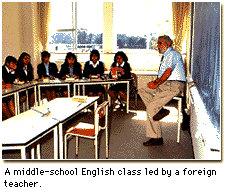 |
When do Japanese kids start studying foreign languages? |
 |
 For most Japanese
schoolchildren, foreign language study starts with English in the first
year of middle school (seventh grade). Only a very few private schools
teach English at the elementary-school level. But now people are considering
the idea of starting English language lessons earlier, even in public
schools, so that children will have more of a chance to become familiar
with the culture of other countries. For most Japanese
schoolchildren, foreign language study starts with English in the first
year of middle school (seventh grade). Only a very few private schools
teach English at the elementary-school level. But now people are considering
the idea of starting English language lessons earlier, even in public
schools, so that children will have more of a chance to become familiar
with the culture of other countries.
Some people complain about the way English is taught at Japanese middle
schools and high schools.
The Japanese government is cooperating with cities and towns in carrying out the JET (Japan Exchange and Teaching) Program. Under this program, which was started in 1987, more than 38,700 young people from other countries have come to Japan to live here for a few years and teach foreign languages at Japanese schools. In 1998, there were 5,096 such Assistant Language Teachers living and working in Japan. Most of those invited to Japan have been from English-speaking countries, such as the United States, Britain, Australia, New Zealand, Canada, and Ireland; there have also been a few invited from France and Germany. Photos courtesy of Tokyo Metropolitan Government and Asahi Shogakusei Shimbun. |
 | |
 Most high schools offer
only English as a foreign language, but some schools provide classes
in two or more, such as Chinese, French, German, Korean, and Spanish.
At the college level, students are required to study two foreign languages.
Most high schools offer
only English as a foreign language, but some schools provide classes
in two or more, such as Chinese, French, German, Korean, and Spanish.
At the college level, students are required to study two foreign languages.
 Even after learning English for six years, many students graduating
from high school still can't speak the language very freely, though
they may be able to read and write in English. The lessons concentrate
heavily on grammar to prepare the students for the English tests that
are given as part of the entrance exams for high schools and colleges.
But nowadays Japanese people have more chances to visit other countries
and meet foreigners living in Japan. So in order to help students learn
to express themselves smoothly in English, an increasing number of middle
and high schools are using foreign teachers.
Even after learning English for six years, many students graduating
from high school still can't speak the language very freely, though
they may be able to read and write in English. The lessons concentrate
heavily on grammar to prepare the students for the English tests that
are given as part of the entrance exams for high schools and colleges.
But nowadays Japanese people have more chances to visit other countries
and meet foreigners living in Japan. So in order to help students learn
to express themselves smoothly in English, an increasing number of middle
and high schools are using foreign teachers.
